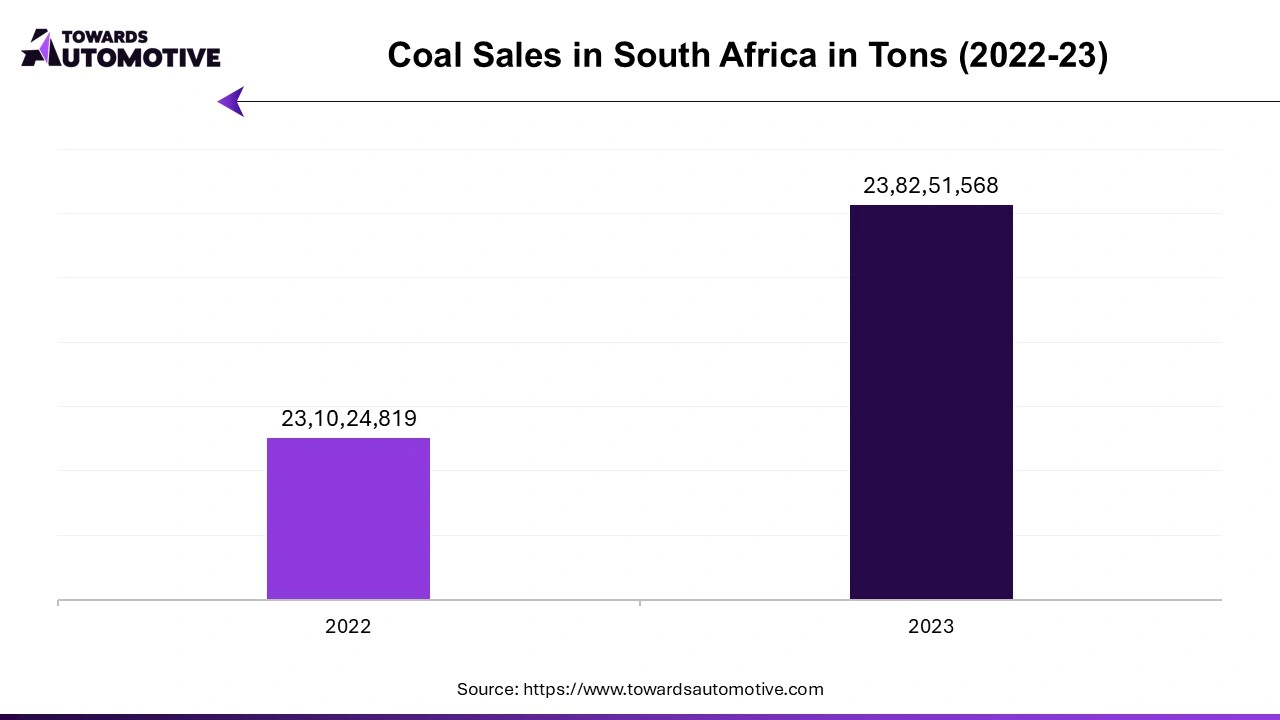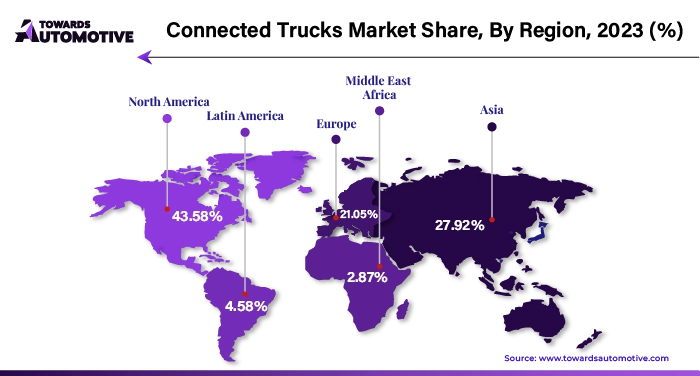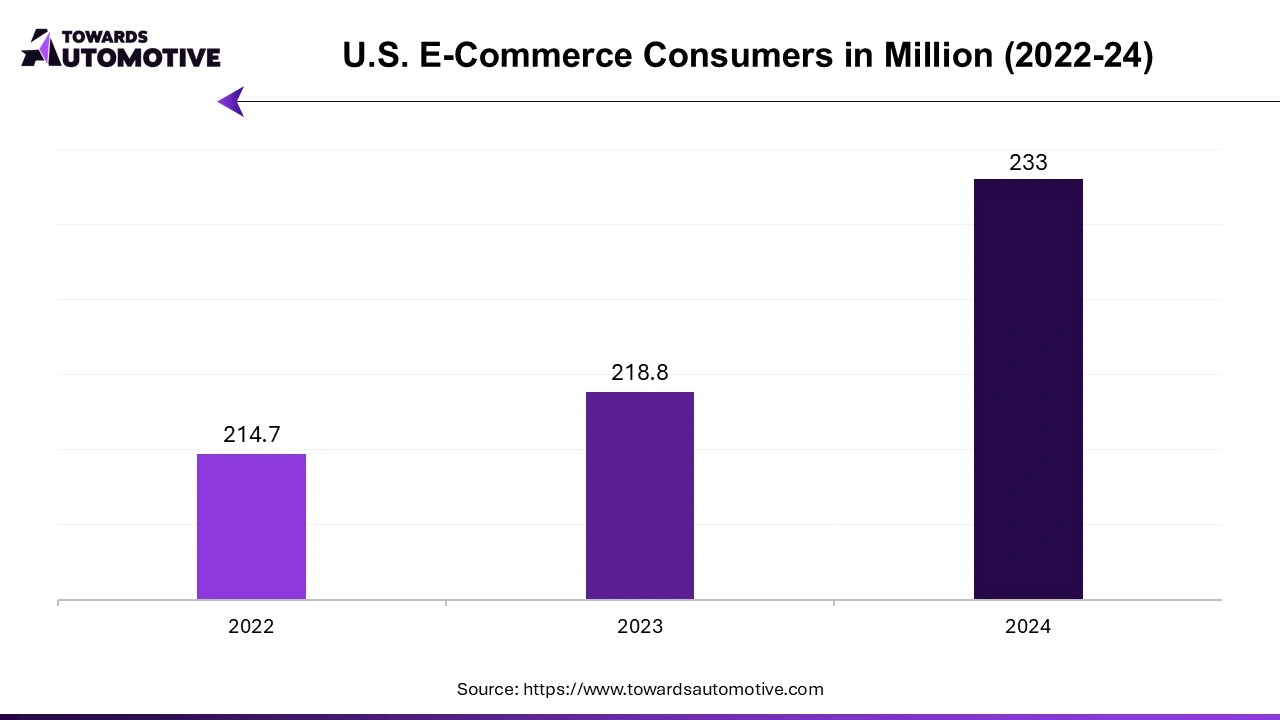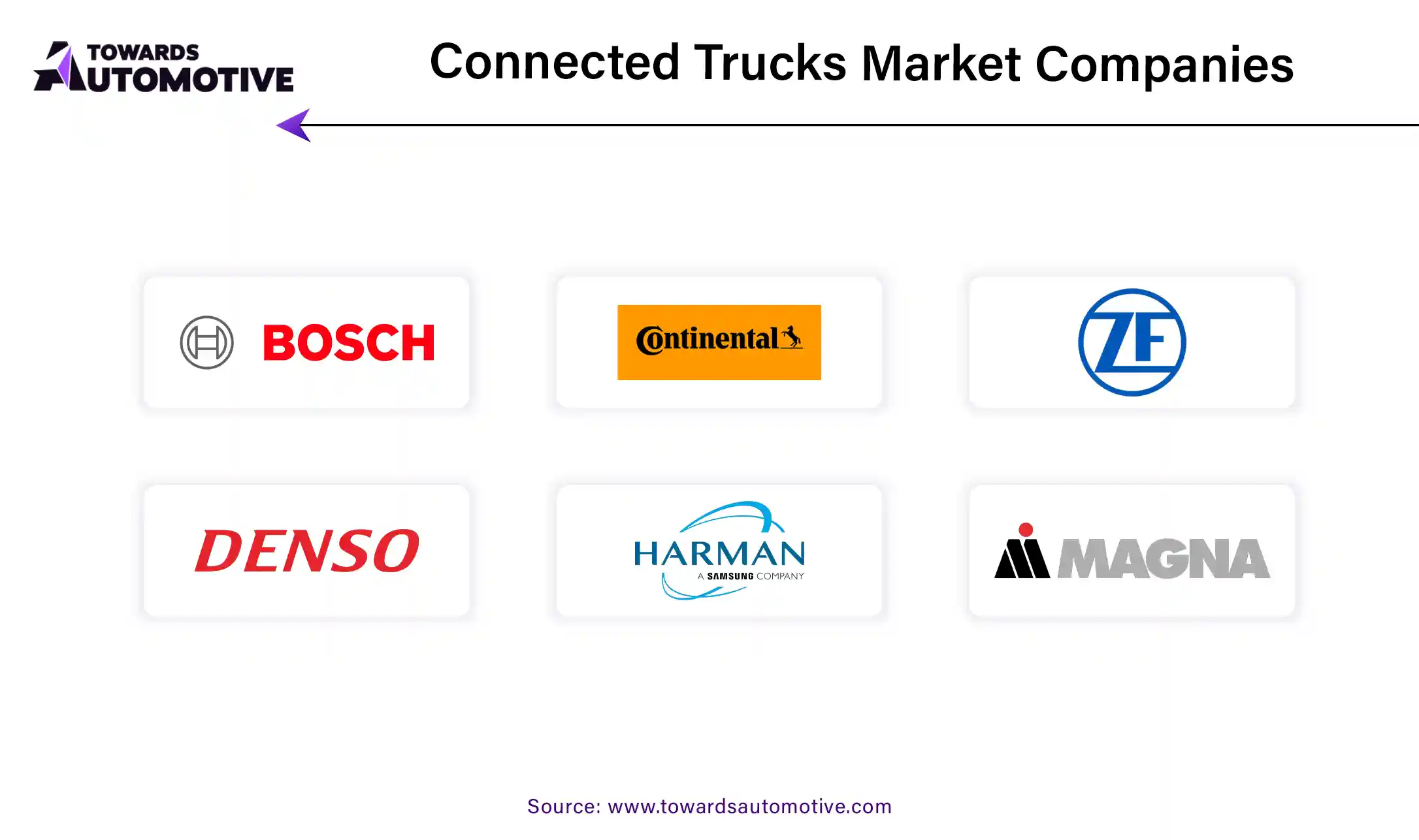February 2025

Senior Research Analyst

Reviewed By
The connected trucks market is forecasted to expand from USD 133.21 billion in 2025 to USD 419.36 billion by 2034, growing at a CAGR of 13.59% from 2025 to 2034.

The connected trucks market is rapidly growing as advancements in technology and increasing demand for smarter, more efficient transportation solutions drive the integration of connectivity features in commercial vehicles. Connected trucks utilize a range of technologies, including telematics, GPS, IoT sensors, and Vehicle-to-Everything (V2X) communication, to enable real-time data exchange between vehicles, drivers, fleet managers, and infrastructure. This connectivity enhances operational efficiency, reduces downtime, and improves overall safety, making connected trucks a valuable asset for logistics and transportation companies.
One of the primary drivers of growth in the connected trucks market is the need for optimized fleet management. Through advanced telematics systems, fleet managers can monitor vehicle performance, track routes, and analyze driver behavior, leading to better fuel efficiency, reduced maintenance costs, and improved productivity. The ability to predict and prevent breakdowns through predictive maintenance further minimizes disruptions, enhancing the reliability of fleets. Additionally, real-time tracking and route optimization enable more efficient deliveries, which is particularly crucial as the e-commerce sector expands.
Moreover, connected trucks play a vital role in improving safety on the roads. By leveraging V2X communication and advanced driver assistance systems (ADAS), these vehicles can detect potential hazards, such as traffic congestion or accidents, and take proactive measures to avoid collisions. Governments and regulatory bodies are also supporting the adoption of connected vehicle technologies by implementing stricter safety standards and promoting the development of intelligent transportation systems.
As the transportation industry continues to embrace digitalization, the connected trucks market is expected to grow significantly. With benefits such as reduced operational costs, enhanced safety, and more efficient logistics, connected trucks are becoming a key component in modernizing the global supply chain and addressing the evolving needs of the commercial vehicle sector.
AI plays a transformative role in the connected trucks market, driving advancements in efficiency, safety, and operational management. One of the key applications of AI in connected trucks is predictive maintenance. By analyzing real-time data from various truck components, AI-powered systems can predict potential failures before they occur, allowing fleet managers to address maintenance issues proactively. This reduces vehicle downtime, minimizes repair costs, and extends the lifespan of trucks, improving overall fleet efficiency.
AI also enhances route optimization in connected trucks by analyzing traffic patterns, weather conditions, and fuel consumption data to recommend the most efficient routes. This not only reduces fuel costs but also ensures timely deliveries, which is particularly important in sectors like logistics and e-commerce. Moreover, AI enables smart fleet management by offering insights into driver behavior, vehicle performance, and operational trends, helping fleet operators make informed decisions.
In terms of safety, AI contributes significantly by enabling advanced driver assistance systems (ADAS) such as collision detection, lane-keeping assistance, and adaptive cruise control. These systems can react faster than human drivers, helping to avoid accidents and improve road safety. Additionally, AI-powered V2X (Vehicle-to-Everything) communication enables trucks to interact with each other, infrastructure, and other road users, facilitating better traffic management and reducing the risk of collisions.
As AI continues to evolve, its integration with connected trucks is expected to drive innovation in autonomous driving technology, pushing the industry towards a future of self-driving commercial vehicles. In summary, AI's role in the connected trucks market is crucial for enhancing operational efficiency, safety, and the overall performance of fleets.
The growth of the mining sector is playing a significant role in driving the expansion of the connected trucks market. As mining operations become more complex and expansive, the need for efficiency, safety, and cost-effectiveness is greater than ever. Connected trucks offer solutions to these needs by integrating advanced telematics and fleet management systems that allow mining companies to monitor and optimize their vehicle fleets in real-time. These systems enable better route planning, fuel consumption tracking, and predictive maintenance, reducing operational costs and improving productivity, which is critical in large-scale mining operations.
One of the most critical benefits of connected trucks in mining is improved safety. Mining environments are hazardous, with challenging terrains and often unpredictable conditions. Connected trucks equipped with Advanced Driver Assistance Systems (ADAS) such as collision avoidance, blind-spot monitoring, and lane-keeping assistance can help minimize accidents and ensure safer operations. Additionally, by enabling remote monitoring and automation, connected trucks reduce the need for human drivers in dangerous areas, further improving safety outcomes in the mining sector.
The demand for greater efficiency and sustainability in the mining industry is also contributing to the adoption of connected trucks. These vehicles help optimize the transport of extracted materials by reducing idle time, preventing delays, and enhancing overall logistics. This results in more efficient use of resources and lower fuel consumption, aligning with the growing focus on sustainability within the mining sector. With environmental regulations becoming stricter, mining companies are under pressure to minimize their carbon footprint, and connected truck technology is an effective solution for achieving this.

The connected trucks market faces several restraints that could hinder its growth. High initial investment costs associated with the installation of advanced telematics, sensors, and communication technologies in trucks pose a significant barrier, especially for smaller fleet operators. Additionally, data security and privacy concerns are prominent, as connected trucks rely on continuous data transmission, making them vulnerable to cyber-attacks. Limited infrastructure for supporting connected technologies, such as inconsistent internet coverage in remote or rural areas, also restricts the seamless operation of connected trucks. Furthermore, the market is restrained by regulatory challenges and the slow adoption of standardized communication protocols across regions, complicating cross-border operations.
The rise of autonomous trucks presents significant opportunities in the connected trucks market, fundamentally transforming logistics and transportation. As automation technologies advance, trucks equipped with autonomous features can communicate seamlessly with other vehicles and infrastructure, enhancing safety and efficiency on the roads. These trucks leverage advanced sensors, artificial intelligence, and real-time data analysis to navigate complex environments, reducing the potential for accidents and improving overall road safety. Additionally, autonomous trucks can operate more efficiently than traditional vehicles, optimizing routes and reducing fuel consumption through intelligent navigation systems. This efficiency not only lowers operational costs for fleet operators but also aligns with sustainability goals by minimizing emissions. Furthermore, the integration of autonomous trucks into connected fleets facilitates better utilization of resources, allowing for more flexible and responsive supply chain management. As logistics companies increasingly seek to optimize their operations, the demand for connected technologies that support autonomous vehicles will grow, driving innovation in telematics and data analytics. Overall, the development of autonomous trucks creates a synergistic effect in the connected trucks market, leading to enhanced safety, efficiency, and sustainability in transportation. This evolution opens new avenues for investment and technological advancement, paving the way for a more connected and automated future in logistics.
The vehicle to vehicle (V2V) segment led the industry. The Vehicle-to-Vehicle (V2V) communication segment is a key driver of growth in the connected trucks market, revolutionizing how commercial vehicles interact on the road. V2V technology enables trucks to exchange real-time information such as speed, direction, location, and braking status with other vehicles in proximity. This constant data exchange enhances situational awareness and helps prevent accidents by providing early warnings about potential hazards, such as sudden braking, vehicles entering blind spots, or traffic congestion ahead. As a result, V2V communication significantly improves road safety, a critical factor driving the adoption of connected trucks.
One of the main advantages of V2V communication is its ability to enable coordinated driving and platooning. In truck platooning, multiple trucks equipped with V2V technology travel closely together in a convoy, with only the lead truck actively being driven. The following trucks automatically adjust their speed and braking in response to the lead truck, creating a safer and more efficient driving experience. This reduces fuel consumption by lowering aerodynamic drag and optimizes traffic flow, contributing to significant cost savings for fleet operators.
Moreover, the growing focus on reducing road accidents and enhancing road safety has led to increased regulatory support for V2V technology. Governments and regulatory bodies in various regions are encouraging the adoption of V2V communication as part of intelligent transportation systems (ITS). In North America and Europe, mandates and standards are being developed to accelerate the deployment of V2V systems in commercial vehicles, further driving market growth.
As V2V technology continues to evolve with advancements in artificial intelligence and 5G networks, its integration into connected trucks is set to enhance operational efficiency, improve fuel economy, and enhance overall safety. This will solidify V2V communication’s role as a critical driver of the connected trucks market in the years to come.
The light commercial vehicle segment held a dominant share of the market. Light commercial vehicles (LCVs) are playing a significant role in driving the growth of the connected trucks market. As the demand for last-mile delivery services, urban logistics, and small-scale transportation solutions grows, particularly due to the rise of e-commerce, LCVs have become an essential component of the global transportation ecosystem. Connected technology enhances the functionality of these vehicles by optimizing route planning, monitoring driver behavior, and improving fuel efficiency, making them more efficient and cost-effective for businesses operating in urban and suburban environments.
One of the primary benefits of connected LCVs is the ability to streamline fleet management. With the integration of telematics and real-time data analytics, fleet managers can track the location, performance, and maintenance needs of their vehicles. This not only reduces operational costs by optimizing routes and minimizing idle time but also ensures timely deliveries, which is crucial for businesses competing in the fast-paced world of e-commerce. The ability to monitor vehicle health in real-time helps reduce breakdowns and maintenance costs, leading to improved vehicle uptime and productivity.
Safety is another key factor driving the adoption of connected technology in LCVs. Features such as advanced driver assistance systems (ADAS), including lane-keeping assist, collision avoidance, and adaptive cruise control, enhance driver safety, reducing the likelihood of accidents and ensuring cargo and drivers reach their destinations securely. This is particularly important in crowded urban areas, where safety concerns are heightened.
Additionally, as governments worldwide implement stricter emissions regulations, connected LCVs offer solutions for managing fuel consumption and reducing carbon emissions through intelligent fuel management systems. This ensures compliance with environmental regulations while reducing operational costs, further driving the adoption of connected LCVs in the logistics and transportation sectors.

North America dominated the connected trucks market. The connected trucks market in North America is experiencing significant growth, driven by rising e-commerce, a focus on fleet efficiency, and an increasing emphasis on safety. The surge in e-commerce, particularly accelerated by the pandemic, has fueled the demand for efficient logistics and transportation solutions. As consumers increasingly rely on online shopping, companies are expanding their delivery networks, leading to greater investments in connected truck technologies. Real-time tracking, route optimization, and telematics solutions are crucial in managing delivery fleets, ensuring timely deliveries, and minimizing costs, which are all essential for sustaining e-commerce growth.
In addition to e-commerce, fleet operators in North America are increasingly focusing on efficiency. Connected trucks enable fleet managers to monitor vehicle health, track fuel consumption, and optimize driving routes through advanced telematics systems. This leads to significant savings in fuel costs, reduces vehicle downtime, and extends the life of the fleet. Moreover, predictive maintenance solutions help detect potential vehicle issues before they become costly breakdowns, further enhancing fleet efficiency and cutting operational costs. As businesses seek to maximize productivity while minimizing expenses, connected truck technology is becoming a key factor in driving this shift.
Safety is another critical factor driving the growth of connected trucks in North America. Advanced Driver Assistance Systems (ADAS), such as lane departure warnings, adaptive cruise control, and collision avoidance systems, are increasingly being integrated into connected trucks to improve driver safety and reduce accident risks. These systems not only protect drivers but also reduce liability for fleet operators, making safety a key consideration for the adoption of connected trucks. With regulatory bodies such as the National Highway Traffic Safety Administration (NHTSA) encouraging the use of safety technologies, the market is poised for continued growth.

Europe is expected to grow with a significant CAGR during the forecast period. The connected trucks market in Europe is being driven by several key factors, including logistics and supply chain optimization, environmental regulations and sustainability, as well as collaborations and public-private partnerships. Logistics and supply chain optimization has become increasingly vital in Europe due to the region’s extensive cross-border commerce and complex transportation networks. Connected truck technologies, such as real-time tracking, telematics, and route optimization, allow fleet operators to enhance delivery efficiency, reduce transit times, and optimize fuel consumption. By integrating connected systems, logistics companies can streamline operations, reduce costs, and ensure timely deliveries across multiple countries, creating a significant demand for connected truck solutions.
Environmental regulations and sustainability are also crucial growth drivers in the European market. Europe has some of the world’s strictest environmental policies, pushing industries to adopt greener technologies. Connected trucks help fleet operators comply with these regulations by enabling fuel-efficient driving through route optimization and real-time monitoring of emissions. In addition, the rise of electric and hybrid trucks in Europe is enhanced by connected technologies, allowing seamless integration of energy management systems to further reduce carbon footprints. The focus on sustainability aligns with both regulatory requirements and consumer preferences, making connected trucks an essential tool for fleet operators striving to meet environmental goals.
Collaborations and public-private partnerships are another driving force behind the growth of the connected trucks market in Europe. Governments, technology providers, and vehicle manufacturers are working together to develop smart transportation infrastructure, including 5G networks and vehicle-to-everything (V2X) communication systems. These partnerships are fostering innovation and accelerating the adoption of connected truck technologies. The European Union’s investment in intelligent transportation systems (ITS) and smart city projects further supports the deployment of connected trucks, promoting safer and more efficient transport networks.

By Communication Type
By Vehicle Type
By Region
February 2025
February 2025
February 2025
February 2025
Dr. Arjun Patel is a distinguished expert in the automotive industry, holding advanced degrees in Automotive Engineering and Mechanical Engineering. His expertise spans automotive market dynamics, technological advancements, and sustainable practices. Dr. Patel excels in conducting in depth research and analysis on market trends, consumer preferences, and the economic implications within the automotive sector. He is renowned for his insightful publications on topics such as electric vehicles, autonomous driving technologies, and the evolution of sustainable transportation solutions. Dr. Patels research contributions have significantly advanced understanding in the field, earning him recognition as a leading authority in automotive research and analysis.
We offer automotive expertise for market projections and customizable research, adaptable to diverse strategic approaches.
Contact Us